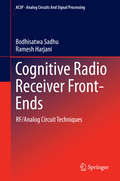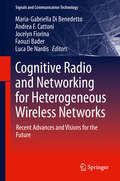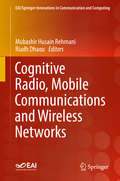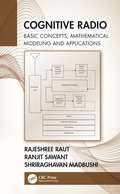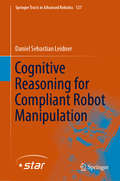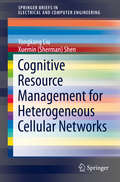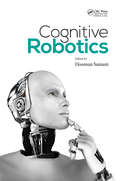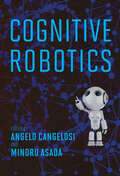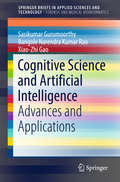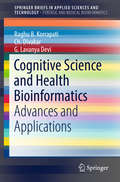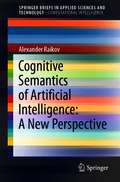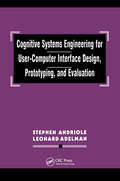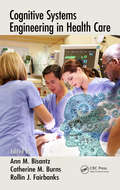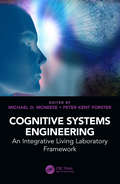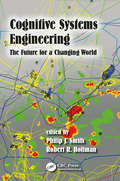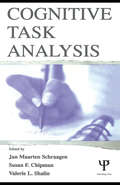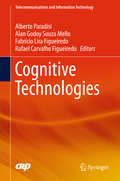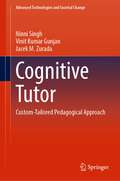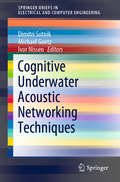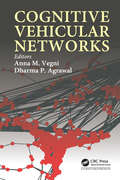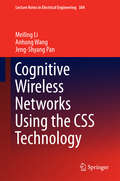- Table View
- List View
Cognitive Radio Receiver Front-Ends: RF/Analog Circuit Techniques (Analog Circuits and Signal Processing #115)
by Bodhisatwa Sadhu Ramesh HarjaniThis book focuses on the architecture and circuit design for cognitive radio receiver front-ends. The authors first provide a holistic explanation of RF circuits for cognitive radio systems. This is followed by an in-depth exploration of existing techniques that can be utilized by circuit designers. Coverage also includes novel circuit techniques and architectures that can be invaluable for designers for cognitive radio systems.
Cognitive Radio and Networking for Heterogeneous Wireless Networks: Recent Advances and Visions for the Future (Signals and Communication Technology)
by Maria-Gabriella Di Benedetto Faouzi Bader Andrea F. Cattoni Jocelyn Fiorina Luca De NardisThis book, written by leading experts from academia and industry, offers a condensed overview on hot topics among the Cognitive Radios and Networks scientific and industrial communities (including those considered within the framework of the European COST Action IC0902) and presents exciting visions for the future. Examples of the subjects considered include the design of new filter bank-based air interfaces for spectrum sharing, medium access control design protocols, the design of cloud-based radio access networks, an evolutionary vision for the development and deployment of cognitive TCP/IP, and regulations relevant to the development of a spectrum sharing market. The concluding chapter comprises a practical, hands-on tutorial for those interested in developing their own research test beds. By focusing on the most recent advances and future avenues, this book will assist researchers in understanding the current issues and solutions in Cognitive Radios and Networks designs.
Cognitive Radio and its Application for Next Generation Cellular and Wireless Networks (Lecture Notes in Electrical Engineering #116)
by Gabriel-Miro Muntean Hrishikesh VenkataramanThis book provides a broad introduction to Cognitive Radio, which attempts to mimic human cognition and reasoning applied to Software Defined Radio and reconfigurable radio over wireless networks. It provides readers with significant technical and practical insights into different aspects of Cognitive Radio, starting from a basic background, the principle behind the technology, the inter-related technologies and application to cellular and vehicular networks, the technical challenges, implementation and future trends. The discussion balances theoretical concepts and practical implementation. Wherever feasible, the different concepts explained are linked to application of the corresponding scheme in a particular wireless standard. This book has two sections: the first section begins with an introduction to cognitive radio and discusses in detail various, inter-dependent technologies such as network coding, software-based radio, dirty RF, etc. and their relation to cognitive radio. The second section deals with two key applications of cognitive radio - next generation cellular networks and vehicular networks. The focus is on the impact and the benefit of having cognitive radio-based mechanisms for radio resource allocation, multihop data transmission, co-operative communication, cross-layer solutions and FPGA-level framework design, as well as the effect of relays as cognitive gateways and real-time, seamless multimedia transmission using cognitive radio.
Cognitive Radio, Mobile Communications and Wireless Networks (EAI/Springer Innovations in Communication and Computing)
by Mubashir Husain Rehmani Riadh DhaouThis book provides an overview of the latest research and development of new technologies for cognitive radio, mobile communications, and wireless networks. The contributors discuss the research and requirement analysis and initial standardization work towards 5G cellular systems and the capacity problems it presents. They show how cognitive radio, with the capability to flexibly adapt its parameters, has been proposed as the enabling technology for unlicensed secondary users to dynamically access the licensed spectrum owned by legacy primary users on a negotiated or an opportunistic basis. They go on to show how cognitive radio is now perceived in a much broader paradigm that will contribute to solve the resource allocation problem that 5G requirements raise. The chapters represent hand-selected expanded papers from EAI sponsored and hosted conferences such as the 12th EAI International Conference on Mobile and Ubiquitous Systems, the 11th EAI International Conference on Heterogeneous Networking for Quality, Reliability, Security and Robustness, the 10th International Conference on Cognitive Radio Oriented Wireless Networks, the 8th International Conference on Mobile Multimedia Communications, and the EAI International Conference on Software Defined Wireless Networks and Cognitive Technologies for IoT.
Cognitive Radio: Basic Concepts, Mathematical Modeling and Applications
by Rajeshree Raut Ranjit Sawant Shriraghavan MadbushiGlobally considered as one of the key technologies in the field of wireless communications, cognitive radio has the capability to solve the issues related to radio spectrum scarcity with the help of dynamic spectrum allocation. It discusses topics including software defined radio architecture, linear predictive coding, variance fractal compression, optimal Codec design for mobile communication system, digital modulation techniques, spectrum sensing in cognitive radio networks and orthogonal frequency division multiplexing in depth. The text is primarily written for senior undergraduate and graduate students, in learning experimental techniques, designing and implementing models in the field wireless communication.
Cognitive Radio: Computing Techniques, Network Security and Challenges
by Budati Anil KumarThe scarcity of radio spectrum is one of the most urgent issues at the forefront of future network research that is yet to be addressed. To address the problem of spectrum usage efficiency, the cognitive radio (CR) concept was proposed. The challenges of employing CRs include ensuring secure device operations and data transmission with advanced computing techniques. Successful development of CR systems will involve attainment of the following key objectives: Increasing the rate and capacity of CR-based networks How the power is utilized in CR hardware devices with CMOS circuits How the framework is needed in complex networks Vedic multipliers on CR networks Spatial analysis and clustering methods for traffic management To transmit a large volume of data like video compression Swarm optimization algorithms Resource sharing in peer-to-peer networking This book gathers the latest research works focusing on the issues, challenges, and solutions in the field of Cognitive Radio Networks, with various techniques. The chapters in this book will give solutions to the problems that Industry 4.0 faces, and will be an essential resource for scholars in all areas of the field.
Cognitive Reasoning for Compliant Robot Manipulation (Springer Tracts in Advanced Robotics #127)
by Daniel Sebastian LeidnerIn order to achieve human-like performance, this book covers the four steps of reasoning a robot must provide in the concept of intelligent physical compliance: to represent, plan, execute, and interpret compliant manipulation tasks. A classification of manipulation tasks is conducted to identify the central research questions of the addressed topic.It is investigated how symbolic task descriptions can be translated into meaningful robot commands.Among others, the developed concept is applied in an actual space robotics mission, in which an astronaut aboard the International Space Station (ISS) commands the humanoid robot Rollin' Justin to maintain a Martian solar panel farm in a mock-up environment
Cognitive Resource Management for Heterogeneous Cellular Networks (SpringerBriefs in Electrical and Computer Engineering)
by Yongkang Liu Xuemin Sherman ShenThis Springer Brief focuses on cognitive resource management in heterogeneous cellular networks (Het Net) with small cell deployment for the LTE-Advanced system. It introduces the Het Net features, presents practical approaches using cognitive radio technology in accommodating small cell data relay and optimizing resource allocation and examines the effectiveness of resource management among small cells given limited coordination bandwidth and wireless channel uncertainty. The authors introduce different network characteristics of small cell, investigate the mesh of small cell access points in parallel with macrocells in network control and resource management and address resource management in the backhaul with coordination constraints and wireless channel uncertainty. The final section of this brief summarizes and provides future research directions for this topic, including a proposed framework that has been evaluated through realistic simulations. Cognitive Resource Management for Heterogeneous Cellular Networks is designed for researchers and professionals working in wireless communications and networks. Advanced-level students studying electrical and computer engineering should also find the content helpful.
Cognitive Robotics
by Hooman SamaniThe kimono-clad android robot that recently made its debut as the new greeter at the entrance of Tokyo's Mitsukoshi department store is just one example of the rapid advancements being made in the field of robotics.Cognitive robotics is an approach to creating artificial intelligence in robots by enabling them to learn from and respond to real-worl
Cognitive Robotics (Intelligent Robotics and Autonomous Agents series)
by Angelo Cangelosi and Minoru AsadaThe current state of the art in cognitive robotics, covering the challenges of building AI-powered intelligent robots inspired by natural cognitive systems.A novel approach to building AI-powered intelligent robots takes inspiration from the way natural cognitive systems—in humans, animals, and biological systems—develop intelligence by exploiting the full power of interactions between body and brain, the physical and social environment in which they live, and phylogenetic, developmental, and learning dynamics. This volume reports on the current state of the art in cognitive robotics, offering the first comprehensive coverage of building robots inspired by natural cognitive systems. Contributors first provide a systematic definition of cognitive robotics and a history of developments in the field. They describe in detail five main approaches: developmental, neuro, evolutionary, swarm, and soft robotics. They go on to consider methodologies and concepts, treating topics that include commonly used cognitive robotics platforms and robot simulators, biomimetic skin as an example of a hardware-based approach, machine-learning methods, and cognitive architecture. Finally, they cover the behavioral and cognitive capabilities of a variety of models, experiments, and applications, looking at issues that range from intrinsic motivation and perception to robot consciousness. Cognitive Robotics is aimed at an interdisciplinary audience, balancing technical details and examples for the computational reader with theoretical and experimental findings for the empirical scientist.
Cognitive Science and Artificial Intelligence: Advances and Applications (SpringerBriefs in Applied Sciences and Technology)
by Xiao-Zhi Gao Sasikumar Gurumoorthy Bangole Narendra Kumar RaoThis book presents interdisciplinary research on cognition, mind and behavior from an information processing perspective. It includes chapters on Artificial Intelligence, Decision Support Systems, Machine Learning, Data Mining and Support Vector Machines, chiefly with regard to the data obtained and analyzed in Medical Informatics, Bioinformatics and related disciplines. The book reflects the state-of-the-art in Artificial Intelligence and Cognitive Science, and covers theory, algorithms, numerical simulation, error and uncertainty analysis, as well novel applications of new processing techniques in Biomedical Informatics, Computer Science and its applied areas. As such, it offers a valuable resource for students and researchers from the fields of Computer Science and Engineering in Medicine and Biology.
Cognitive Science and Health Bioinformatics: Advances and Applications (SpringerBriefs in Applied Sciences and Technology)
by Raghu B. Korrapati Ch. Divakar G. Lavanya DeviThis book highlights the interdisciplinary study of cognition, mind and behavior from an information processing perspective, and describes related applications to health informatics. The respective chapters address health problem-solving and education, decision support systems, user-centered interfaces, and the design and use of controlled medical terminologies. Reflecting cutting-edge research on computational methods - including theory, algorithms, numerical simulation, error and uncertainty analysis, and their applications - the book offers a valuable resource for doctoral students and researchers in the fields of Computer Science and Engineering.
Cognitive Semantics of Artificial Intelligence: A New Perspective (SpringerBriefs in Applied Sciences and Technology)
by Alexander RaikovThis book addresses the issue of cognitive semantics’ aspects that cannot be represented by traditional digital and logical means. The problem of creating cognitive semantics can be resolved in an indirect way. The electromagnetic waves, quantum fields, beam of light, chaos control, relativistic theory, cosmic string recognition, category theory, group theory, and so on can be used for this aim. Since the term artificial intelligence (AI) appeared, various versions of logic have been created; many heuristics for neural networks deep learning have been made; new nature-like algorithms have been suggested. At the same time, the initial digital, logical, and neural network principles of representation of knowledge in AI systems have not changed a lot. The researches of these aspects of cognitive semantics of AI are based on the author's convergent methodology, which provides the necessary conditions for purposeful and sustainable convergence of decision-making.
Cognitive Sensors and IoT: Architecture, Deployment, and Data Delivery
by Fadi Al-TurjmanThis book presents the Cognitive Information Centric Sensor Network (CICSN) framework for the IoT. This framework is built on top of cognitive nodes, capable of knowledge representation, learning, and reasoning, along with an information-centric approach for data delivery. <P><P> It also discusses the most appropriate deployment strategy for these cognitive nodes under realistic assumptions that cares about the Quality of Information (QoI). In addition, it uses a QoI aware data delivery strategy, with Analytic Hierarchy Process (AHP) as the reasoning technique to identify data delivery paths that dynamically adapt to changing network conditions and user requirements.
Cognitive Surplus
by Clay ShirkyThe author of the breakout hit Here Comes Everybody reveals how new technology is changing us for the better. In his bestselling Here Comes Everybody, Internet guru Clay Shirky provided readers with a much-needed primer for the digital age. Now, with Cognitive Surplus, he reveals how new digital technology is unleashing a torrent of creative production that will transform our world. For the first time, people are embracing new media that allow them to pool their efforts at vanishingly low cost. The results of this aggregated effort range from mind-expanding reference tools like Wikipedia to life-saving Web sites like Ushahidi.com, which allows Kenyans to report acts of violence in real time. Cognitive Surplus explores what's possible when people unite to use their intellect, energy, and time for the greater good.
Cognitive Systems Engineering for User-computer Interface Design, Prototyping, and Evaluation
by Stephen J. Andriole Leonard AdelmanThis volume seeks to answer the question: "Can findings from cognitive science enhance the user-computer interaction process?" In so doing, it recognizes that user-computer interfaces (UCIs) are often essential parts of an information or decision support system -- and often critical components of software-intensive systems of all kinds. From the outset, the authors note that the design, prototyping, and evaluation of user-computer interfaces are part of larger systems and are therefore ideally designed, developed, and evaluated as part of a larger design and developmental process or "life cycle." Thus, this book describes the process by which functional, nonfunctional, or display-oriented requirements are converted first into prototypes and then into working systems. While the process may at times seem almost mysterious, there is in fact a methodology that drives the process -- a methodology that is defined in terms of an adaptive life cycle. There are a number of steps or phases that comprise the standard life cycle, as well as methods, tools and techniques that permit each step to be taken. Describing the effort to implement this process to enhance user-computer interaction, this book presents a methodological approach that seeks to identify and apply findings from cognitive science to the design, prototyping, and evaluation of user-computer interfaces.
Cognitive Systems Engineering in Health Care
by Catherine M. Burns Ann M. Bisantz Rollin J. FairbanksCognitive systems engineering has been widely and successfully applied in the design of safety critical systems such as nuclear power, aviation, and military command-and-control. More recently, these methods are being applied to the design of health and medical systems in order to improve health care quality, reduce errors and adverse events, and i
Cognitive Systems Engineering: An Integrative Living Laboratory Framework
by Michael D. McNeese Peter Kent ForsterThis book provides a framework for integrating complex systems that are problem-centric, human-centered, and provides an interdisciplinary, multi-methodological purview of multiple perspectives surrounding the human factors/human actors within living ecosystems. This book will provide useful theoretical and practical information to human factors, human-computer interaction, cognitive systems engineering personnel who are currently engaged in human-centered design or other applied aspects of modeling, simulation, and design that requires joint understanding of theory and practice.
Cognitive Systems Engineering: The Future for a Changing World (Expertise: Research and Applications Series)
by Robert R. Hoffman Philip J. SmithThis volume provides an exceptional perspective on the nature, evolution, contributions and future of the field of Cognitive Systems Engineering (CSE). It is a resource to support both the teaching and practice of CSE. It accomplishes this through its organization into two complementary approaches to the topic. <P><P>The first is an historical perspective: In the retrospections of leaders of the field, what have been the seminal achievements of cognitive human factors? What are the "lessons learned" that became foundational to CSE, and how did that foundation evolve into a broader systems view of cognitive work? The second perspective is both pedagogical and future-looking: What are the major conceptual issues that have to be addressed by CSE and how can a new generation of researchers be prepared to further advance CSE? <P><P>Topics include studies of expertise, cognitive work analysis, cognitive task analysis, human performance, system design, cognitive modeling, decision making, human-computer interaction, trust in automation, teamwork and ecological interface design. A thematic focus will be on systems-level analysis, and such notions as resilience engineering and systems-level measurement. The book features broad coverage of many of the domains to which CSE is being applied, among them industrial process control, health care, decision aiding and aviation human factors. <P><P> The book’s contributions are provided by an extraordinary group of leaders and pathfinders in applied psychology, cognitive science, systems analysis and system design. In combination these chapters present invaluable insights, experiences and continuing uncertainties on the subject of the field of CSE, and in doing so honor the career and achievements of Professor David D. Woods of Ohio State University.
Cognitive Task Analysis (Expertise: Research and Applications Series)
by Jan Maarten Schraagen Susan F. Chipman Valerie L. ShalinCognitive task analysis is a broad area consisting of tools and techniques for describing the knowledge and strategies required for task performance. Cognitive task analysis has implications for the development of expert systems, training and instructional design, expert decision making and policymaking. It has been applied in a wide range of settings, with different purposes, for instance: specifying user requirements in system design or specifying training requirements in training needs analysis. The topics to be covered by this work include: general approaches to cognitive task analysis, system design, instruction, and cognitive task analysis for teams. The work settings to which the tools and techniques described in this work have been applied include: 911 dispatching, faultfinding on board naval ships, design aircraft, and various support systems. The editors' goal in this book is to present in a single source a comprehensive, in-depth introduction to the field of cognitive task analysis. They have attempted to include as many examples as possible in the book, making it highly suitable for those wishing to undertake a cognitive task analysis themselves. The book also contains a historical introduction to the field and an annotated bibliography, making it an excellent guide to additional resources.
Cognitive Technologies (Telecommunications and Information Technology)
by Alberto Paradisi Fabrício Lira Figueiredo Alan Godoy Souza Mello Rafael Carvalho FigueiredoThis book focuses on the next generation optical networks as well as mobile communication technologies. The reader will find chapters on Cognitive Optical Network, 5G Cognitive Wireless, LTE, Data Analysis and Natural Language Processing. It also presents a comprehensive view of the enhancements and requirements foreseen for Machine Type Communication. Moreover, some data analysis techniques and Brazilian Portuguese natural language processing technologies are also described here.
Cognitive Tutor: Custom-Tailored Pedagogical Approach (Advanced Technologies and Societal Change)
by Vinit Kumar Gunjan Jacek M. Zurada Ninni SinghThis book illustrates the design, development, and evaluation of personalized intelligent tutoring systems that emulate human cognitive intelligence by incorporating artificial intelligence. Artificial intelligence is an advanced field of research. It is particularly used in the field of education to increase the effectiveness of teaching and learning techniques. With the advancement of internet technology, there is a rapid growth in web based distance learning modality. This mode of learning is better known as the e-learning system. These systems present low intelligence because they offer a pre-identified learning frame to their learners. The advantage of these systems is to offer to learn anytime and anyplace without putting emphasis on a learner's needs, competency level, and previous knowledge. Every learner has different grasping levels, previous knowledge, and preferred mode of learning, and hence, the learning process of one individual may significantly vary from other individuals. This book provides a complete reference for students, researchers, and industry practitioners interested in keeping abreast of recent advancements in this field. It encompasses cognitive intelligence and artificial intelligence which are very important for deriving a roadmap for future research on intelligent systems.
Cognitive Underwater Acoustic Networking Techniques (SpringerBriefs in Electrical and Computer Engineering)
by Michael Goetz Ivor Nissen Dimitri SotnikThis book summarizes the latest research on cognitive network-layer methods and smart adaptive physical-layer methods in underwater networks. Underwater communication requires extendable and delay-tolerant underwater acoustic networks capable of supporting multiple frequency bands, data rates and transmission ranges. The book also discusses a suitable foreground communication stack for mixed mobile/static networks, a technology that requires adaptive physical layer waveforms and cognitive network strategies with underlying cooperative and non-cooperative robust processes. The goal is to arrive at a universally applicable standard in the area of Underwater Internet-of-Things [ISO/IEC 30140, 30142, 30143].
Cognitive Vehicular Networks
by Anna Maria Vegni Dharma P. AgrawalA comprehensive text on both current and emerging areas of cognitive vehicular networks, this book focuses on a new class of mobile ad hoc networks. It uses a pedagogical approach utilizing cognitive aspects applied to vehicular environments and comprises contributions from well-known and high profile researchers in their respective specialties. The book provides significant technical and practical insights on different perspectives, starting from a basic background on cognitive radio, interrelated technologies, application to vehicular networks, technical challenges, and future trends.
Cognitive Wireless Networks Using the CSS Technology (Lecture Notes in Electrical Engineering #384)
by Jeng-Shyang Pan Anhong Wang Meiling LiThe aim of this book is to provide someuseful methods to improve the spectrum sensing performance in a systematic way,and point out an effective method for the application of cognitive radiotechnology in wireless communications. The book gives a a state-of-the-artsurvey and proposes some new cooperative spectrum sensing (CSS) methodsattempting to achieve better performance. For each CSS, the main idea andcorresponding algorithm design are elaborated in detail. This book covers the fundamental concepts and the coretechnologies of CSS, especially its latest developments. Each chapter ispresented in a self-sufficient and independent way so that the reader canselect the chapters interesting to them. The methodologies are described indetail so that the readers can repeat the corresponding experiments easily. It will be a useful book for researchers helping them tounderstand the classifications of CSS, inspiring new ideas about the novel CSStechnology for CR, and learning new ideas from the current status of CSS. Forengineers, it will be a good guidebook to develop practical applications forCSS.
